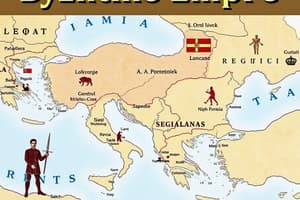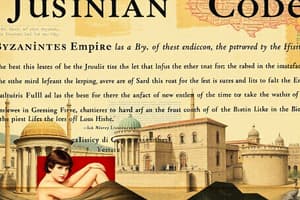Podcast
Questions and Answers
What was the Byzantine Empire?
What was the Byzantine Empire?
The most important center of political, religious, cultural, and economic activity in the world of the former Roman Empire, lasting 1000 years and centered in Constantinople ruled by successors of the Roman Empire.
What were three disagreements that pushed the Eastern and Western Church toward a final confrontation?
What were three disagreements that pushed the Eastern and Western Church toward a final confrontation?
Political/religious authority, liturgical diversity, and the iconoclastic controversy.
What happened to cause Byzantium to eclipse Rome as the center of the Mediterranean world?
What happened to cause Byzantium to eclipse Rome as the center of the Mediterranean world?
The capital was moved from Rome to Constantinople, changing the name from Byzantium to Constantinople.
What were the two major differences between the Byzantine Empire and the Roman Empire?
What were the two major differences between the Byzantine Empire and the Roman Empire?
In terms of faith, what did the Byzantine Empire enjoy that the Roman Empire did not?
In terms of faith, what did the Byzantine Empire enjoy that the Roman Empire did not?
What early disasters did Islam inflict upon the Byzantine Empire?
What early disasters did Islam inflict upon the Byzantine Empire?
Which tenet of Islam promoted Muslims to conquer other peoples?
Which tenet of Islam promoted Muslims to conquer other peoples?
What turned out to be the ruin of the Byzantine Empire and when did this happen?
What turned out to be the ruin of the Byzantine Empire and when did this happen?
What unified Eastern and Western Christianity up to the year 1000?
What unified Eastern and Western Christianity up to the year 1000?
What major traditions came together in Constantinople?
What major traditions came together in Constantinople?
What does it mean to be in 'full communion'?
What does it mean to be in 'full communion'?
Define 'patriarch' - who are they within the Church authority in the Byzantine era, and are they still in authority today?
Define 'patriarch' - who are they within the Church authority in the Byzantine era, and are they still in authority today?
Define 'patriarchate'.
Define 'patriarchate'.
List the 5 patriarchates that existed by the 5th century.
List the 5 patriarchates that existed by the 5th century.
What relationship within the Byzantine Empire tended to undermine the authority of the Pope among the Eastern Christians?
What relationship within the Byzantine Empire tended to undermine the authority of the Pope among the Eastern Christians?
What factors served to emphasize the Latin (Western) Church's independence from secular authority?
What factors served to emphasize the Latin (Western) Church's independence from secular authority?
What feature of the relationship between the 'throne and altar' in the East tended to cause schisms?
What feature of the relationship between the 'throne and altar' in the East tended to cause schisms?
What factors served to emphasize the Byzantine Church's connection with secular authority?
What factors served to emphasize the Byzantine Church's connection with secular authority?
What political situation in the West tended to increase the sense of the universality of the Church?
What political situation in the West tended to increase the sense of the universality of the Church?
Define 'national churches'.
Define 'national churches'.
Explain how the East came into existence.
Explain how the East came into existence.
Explain how the West came into existence.
Explain how the West came into existence.
Flashcards are hidden until you start studying
Study Notes
Byzantine Empire Overview
- The Byzantine Empire served as a significant hub for political, religious, cultural, and economic activities following the Roman Empire's decline.
- It endured for approximately 1000 years with its center in Constantinople, led by Roman Empire successors.
- The capital's relocation from Rome to Constantinople marked Byzantium's emergence as a primary Mediterranean power.
Disagreements Between Eastern and Western Churches
- Key tensions leading to confrontations included issues around political and religious authority, liturgical practices, and the iconoclastic controversy.
Distinctions Between Byzantine and Roman Empires
- The Byzantine Empire lasted 1000 years longer than the Roman Empire and originated with Christianity, contrasting with the Roman Empire's pagan roots.
Islamic Influence on the Byzantine Empire
- Early Islamic conquests resulted in the Byzantine Empire losing control over 3 to 5 significant patriarchates, retaining only Rome and Constantinople.
- The Islamic principle of jihad encouraged the expansion and conquest of other peoples.
Decline of the Byzantine Empire
- The ascendancy of Islam culminated in the fall of Constantinople in 1453, marking the empire's demise.
Unity in Christianity Until 1000
- Eastern and Western Christianity were unified through shared apostolic traditions and sacramental practices.
Cultural Synthesis in Constantinople
- The city was a confluence of Roman law, Greek culture, and oriental customs, creating a rich cultural tapestry.
Full Communion in the Church
- Being in "full communion" means bishops are united, and faithful share one Eucharist, symbolizing ultimate faith unity.
Role of Patriarchs in the Byzantine Church
- Patriarchs, usually archbishops, were appointed by the emperor and governed Church administrative centers, a structure that persists today.
Administrative Aspects of the Church
- The term "patriarchate" refers to an administrative center of the Church.
Major Patriarchates in the 5th Century
- Key patriarchates included:
- Rome (Sts. Peter and Paul)
- Constantinople (St. Andrew)
- Antioch (St. Peter)
- Alexandria (St. Mark)
- Jerusalem (St. James)
Authority Dynamics in Byzantine Christianity
- The emperor-patriarch relationship in Constantinople weakened the Pope's authority among Eastern Christians.
Independence of the Latin Church
- The Latin Church became more autonomous from secular governing influence, which spurred missionary efforts across Europe.
- Ideally, the Church aimed for universality, prioritizing evangelism over national or social boundaries.
Schisms Due to Church-State Relations
- Close ties between Church and secular power in the East led to the emergence of national churches, frequently causing schisms.
Byzantine Church’s Alliance With Secular Authority
- The Byzantine Church closely aligned with the empire, leading to the establishment of national churches based in local governance.
Political Context in the West
- The lack of robust political structures in the West aided the Catholic Church in fostering a sense of universality.
Definition of National Churches
- National churches were linked to specific states where rulers claimed authority in Church affairs.
Emergence of Eastern Christianity
- Eastern Christianity developed from a larger Christian population, with bishops choosing patriarchs and promoting missionary work.
Emergence of Western Christianity
- In the West, temporal rulers respected papal authority, establishing a subordinate relationship to the Church.
Studying That Suits You
Use AI to generate personalized quizzes and flashcards to suit your learning preferences.




